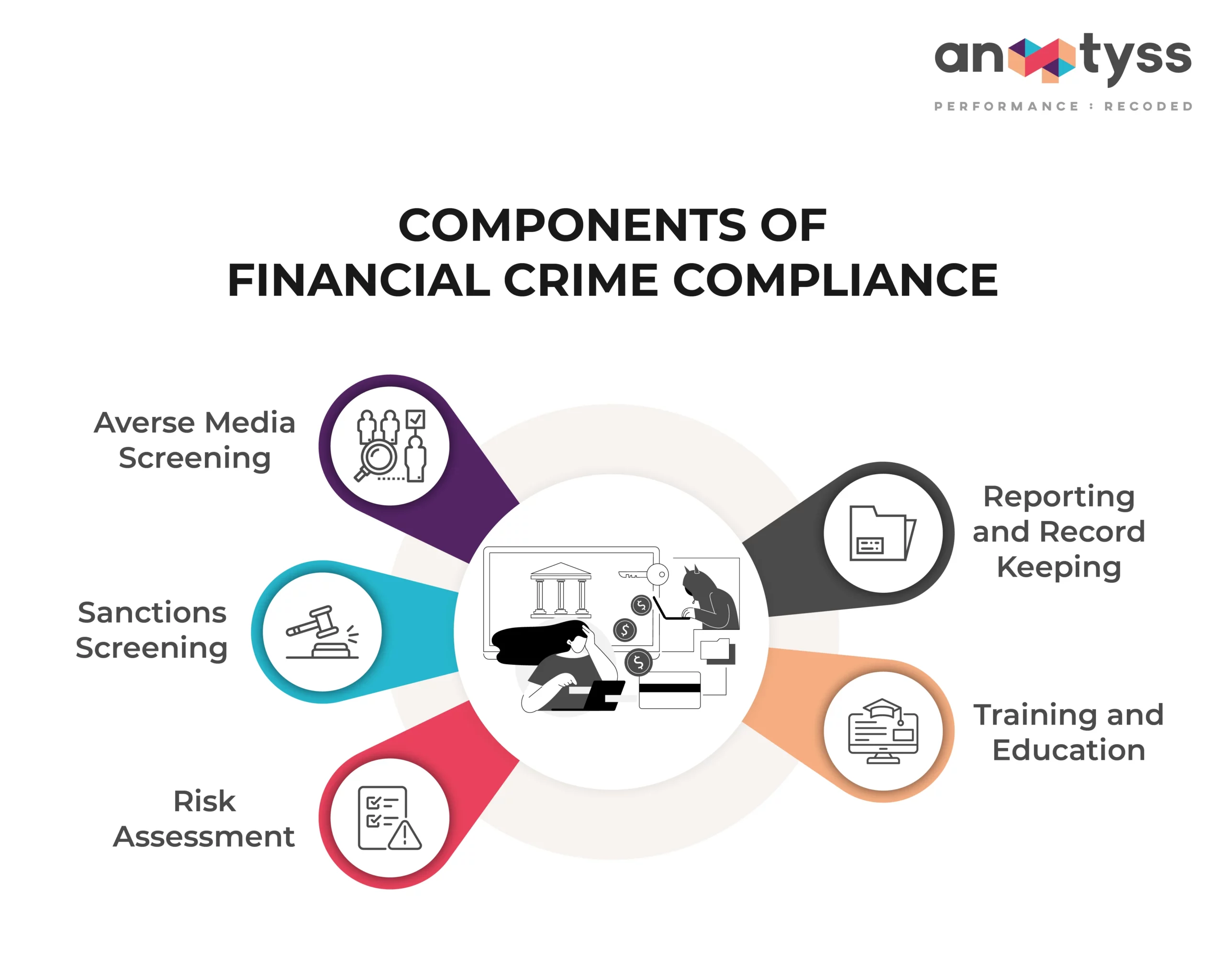Financial Crime Compliance (FCC) is a process to ensure your bank or financial institution is meeting the policies, standards, and regulations laid by the Financial Crimes Enforcement Network (FinCEN) of the United States Treasury Department.
Meeting financial crime compliance is a legal requirement for banks and financial institutions to combat the various financial crime risks and activities. It helps banks and financial institutions detect, prevent, and report illegal financial activities.
The blog discusses the financial crime risks in banking and financial institutions, the cost of financial crimes, and associated challenges. It also highlights the importance of digital solutions to combat financial crimes and strategies to meet the Financial Crime Compliance (FCC) and various other regulatory requirements.
What is Financial Crime?
Financial crime is criminal conduct involving malicious acts against banks and financial institutions committed by individuals, groups, or criminal organizations to steal, manipulate, launder money, finance terrorism, and obtain financial gains and professional advantage.
Financial crime can have devastating impacts on the social and emotional well-being of individuals. For organizations, failure to inculcate financial crime compliance can have significant financial and reputational losses to the organizations. ]
Following are some examples that are normally considered a financial crime,
- Money laundering
- Terrorism financing
- Cybercrime
- Bribery and corruption
- Market manipulation
- Insider dealing
- Tax evasion
- Credit fraud
- Insurance fraud
- Embezzlement
- Theft or forgery
- Slavery/human trafficking
The Importance of Financial Crime Compliance
Financial institutions, such as banks, have always been the prime target for criminals who often exploit the weakness of the sector for personal. Therefore, financial crime compliance has been an important subject that financial institutions cannot ignore. Financial Crime Compliance helps financial institutions:
1. Protect Against Financial Crimes
FCC serves as a first line of defense protecting financial institutions against financial crimes such as money laundering, fraud, and terrorist financing. With robust FCC policies and internal controls, financial institutions ensure that laws are followed and unethical activities are eliminated to protect themselves as well as their customers.
2. Meet Regulatory Obligations
Financial institutions are subject to a vast array of local and international regulations. Non-compliance can result in severe legal and financial consequences. This includes fines and reputational damage.
In 2021, global financial crime fines totaled $9.95 billion, down from 2020’s record-breaking figure of $22.86 billion. Corruption, bribery, and fraud accounted for 69.6% of FinCrime fines handed out in 2021.
Financial crime compliance (FCC) is not a choice; it’s a responsibility.
3. Preserve Trust and Protect Reputation
A robust FCC program also helps financial institutions bolster their reputation in public space. By adhering to compliance standards, institutions demonstrate their commitment to ethical practices that help maintain trust, drive customers, and ensure business growth. It also helps prevent scandals and adverse media coverage that could damage their reputation.
4. Risk Mitigation
Effective FCC practices reduce the risk of financial loss due to fraud and other financial crimes. Financial crime risk management (FCRM) is a forearm of the FCC that helps ensure that the rules are followed. It involves risk assessments, technology solutions, and workforce training.
Global Financial Crime Compliance Requirements
Adherence to the regulatory requirements is critical for financial crime compliance for banks and financial institutions. They need to prioritize and adhere to the following global requirements for financial crime compliance:
Bank Secrecy Act (BSA) and Anti-Money Laundering (AML
Also known as the Currency and Foreign Transactions Reporting Act (CFTRA), the Bank Secrecy Act (BSA) was enacted to identify financial crime activities. Banks and financial institutions are also required to have a robust framework to file reports of cash transactions exceeding $10,000, currency transaction reports (CTRs), and assist the US government to detect and prevent suspected money laundering activities for BSA and anti-money laundering compliance.
Know Your Customer (KYC)
Banks and financial institutions are obligated to verify their customer identities (KYC), understand the nature of their business, and assess the criminal risks they pose. The KYC components include,
1. Customer Identification Program (CIP)
CIP is a critical KYC requirement during customer onboarding. This includes collecting customer information, such as full name, date and place of birth, address, and identification number (any document issued by govt authorities, such as passport or SSN for individuals). Banks and financial institutions need to perform the CIP to meet the KYC and customer risk assessment obligations.
2. Customer Due Diligence (CDD)
CDD refers to the set of processes that involves collecting personal information and identifying a customer with solutions, such as documents or biometrics. It also includes the customer risk assessment by checking the customer data against the database for document verification. It is required at the time of opening an account in the bank or financial institution. CDD is required for customers considered to be low-risk.
3. Enhanced Due Diligence (EDD)
EDD involves protocols to verify and assess high-risk customers or individuals by performing additional checks, which may include more documents, additional database verifications, frequent identity verification, or a combination of all of the mentioned checks. Following are some common factors that may trigger the need for EDD of identified high-risk customers or individuals:
- Politically Exposed Person (PEP)
- People linked to financial crime or money laundering activities in the past
- The person is the subject of averse media
- Individuals on the sanctions list or related to a company or country subjected to sanctions
- A person belonging to a high-risk country.
All FATF members must implement the FATF risk-based approach recommendations to meet CDD and EDD requirements for AML/CFT compliance.
OFAC Sanctions Regulations
Office of Foreign Assets Control or OFAC Sanctions compliance program requires banks and financial institutions to implement a robust system in place to prohibit any financial and trade activities with countries, entities, or individuals engaged in state-sponsored criminal activities, breaches of international laws, the proliferation of weapons of mass destruction, and human right violations. Following are the OFAC sanctions types imposed against individuals, entities, and countries.
1. Primary OFAC Sanctions
Targeted against individuals or entities within the US preventing them from trade or commerce activities with US sanctions targets.
2. Secondary OFAC Sanctions
Prohibits the US persons from doing business with third parties residing in foreign countries but not directly subject to the US jurisdiction.
The USA PATRIOT Act
The Uniting and Strengthening America by Providing Appropriate Tools Required to Intercept and Obstruct Terrorism (USA PATRIOT) Act of 2001 puts forth measures “to deter and prosecute financial crime activities, such as money laundering and financing of terrorism.”
By complying with these regulations, banks and financial institutions can prevent and detect financial crimes, such as fraud, money laundering, and financing of terrorism effectively.
Financial Crime Compliance Challenges
Following are the three major challenges banks and financial institutions encounter when it comes to meeting various financial crime compliances and regulatory requirements.
1. Rapidly Changing Regulations
Preparing for a rapidly changing regulatory environment is a challenge for the banking and finance industries. Failure to comply with federal laws and industry regulations can lead to reputational damage and incur legal penalties. Thus, banks and financial institutions need to be aware of the changes, understand the impact of the regulation, and implement the necessary changes to meet the regulatory changes.
2. Cyber Attacks
The financial services industry is one of the prime targets for cybercriminals. It includes financial crimes, such as stealing credit card or debit card information, gaining access to accounts to initiate unauthorized transactions, identity fraud, and so on.
Even though banks impose the strictest security policies, the risk of cyber security breaches and falling victim to attacks, such as ransomware, malware, phishing, and denial of service attacks, are quite high, which can lead to heavy costs and penalties. It can have dramatic consequences for both customers and financial institutions, irrespective of their size.
3. High Compliance Costs
Compliance costs increase with the increase in individuals or entities operating in different jurisdictions. The average cost to meet the various regulatory compliance, such as AML/CFT, is estimated to be ~$5.5 million. For non-compliance, it is ~$15 million.
Growing Need for Financial Crime Compliance
Financial crime and fraud is a trillion-dollar industry growing at a rapid scale with more sophisticated fraud techniques, such as Synthetic Fraud—also referred to as the crime of the new millennium.
According to one report by Thomas Reuters, the cost of organized financial crimes including human trafficking and slavery was estimated at a staggering $1.45 trillion in 2018. And almost 50% of large APAC organizations have been victims of financial crimes, such as money laundering and fraud.
In addition, companies including banks and other financial institutions spend 3.1%—an aggregate of $1.28 trillion—of total annual turnover to combat financial crimes.
Besides economic losses, financial crime also causes immeasurable harm to the world and humanity. The proceeds of financial crimes are generally used in the financing of terrorism, the proliferation of weapons of mass destruction, human rights abuses, and environmental crimes.
Financial Crime Mitigation
Financial crime mitigation requires banks and other financial institutions to identify vulnerabilities and implement the controls and systems to prevent financial crimes. To achieve this, they can put the following controls in place:
- Batch-level real-time transaction and behavioral monitoring for fraudulent transactions or activities, including suspected money laundering activities
- Real-time global watchlist screening and PEP matching
- KYC risk profiling, Customer Due Diligence (CDD), and Enhanced Due Diligence (EDD)
Banks and financial institutions can also follow the top five key strategies to enhance the efficiency of financial crime compliance programs.
Components of Financial Crime Compliance
Financial crime compliance encompasses several key components:

1. Averse Media Screening
Averse media screening or negative new screening (media monitoring) is one of the KYC processes that comes under the CDD umbrella. It helps identify and analyze damaging information about a person, organization, or entity from different online and offline media channels, including social media.
2. Sanctions Screening
Financial institutions must screen transactions and customers against international sanctions lists or collected customer data for effective financial crime compliance (FCC). It helps financial institutions detect sanctioned individuals, entities, or countries before conducting any business or transaction with them.
3. Risk Assessment
Banks and other financial institutions must conduct periodic risk assessments to identify potential hazards, and weaknesses, and analyze the effects before they occur. This helps them effectively adapt their compliance strategies accordingly.
4. Reporting and Record Keeping
Financial institutions must maintain accurate and accessible records and report certain transactions and suspicious activities (SAR) to regulatory authorities. This is a critical step to demonstrate control over the customer onboarding process. These records also help in investigating the audit trail of any money laundering or terrorist financing activity.
5. Training and Education
Staff members need to be adequately trained to recognize and address financial crime risks effectively. Fostering a deep understanding of financial crime risks and compliance requirements helps create awareness about the intricacies of various financial crimes and empowers individuals within banks and financial institutions to navigate a complex regulatory landscape. It helps employees:
- Stay updated, and adapt to emerging threats
- Detect suspicious activities
- Assess risks
- Develop robust compliance frameworks
- Enhance skills for more effective detection and prevention of financial crimes.
Financial Crime Compliance Solutions: Manual Vs. Digital
Digital financial crime compliance solutions, such as Robotic Process Automation (RPA) embedded with artificial intelligence and machine-learning capabilities, can help address the challenges in traditional solutions with real-time tracking and monitoring of transactions with high accuracy.
By leveraging these intelligent digital solutions, banks, and financial institutions can analyze the data and detect suspicious activities and transactions. They can also generate audit trails to support compliance and save the organization from penalties and the high cost involved in the manual or traditional approach, which is prone to errors.
Consultative Approach for Financial Crime Compliance Management
Financial crimes, such as money laundering, terrorist financing, fraud, bribery, and corruption, pose a greater threat to the integrity of banks and financial institutions across the globe. Failure to manage the risk of financial crime can have severe consequences, including loss of reputation and goodwill, penalties, and regulatory sanctions.
At Anaptyss, we help banks and financial institutions fulfill their financial crime compliance obligations in a customized manner with our Digital Knowledge OperationsTM (DKOTM) framework. The DKOTM framework empowers banks of any size to protect their customers, and reputation and avoid regulatory fines or sanctions.
Interested in knowing how the DKOTM-based solution approach can help your financial institution to attain financial crime compliance? Read how Anaptyss offered a consultative BSA/AML-focused risk mitigation program for a US-based community bank by implementing the DKOTM framework to meet the regulatory requirements.
Write to us: [email protected].

Anaptyss Team
Anaptyss is a digital solutions specialist on a mission to simplify and democratize digital transformation for regional/super-regional banks, mortgages and commercial lenders, wealth and asset management firms, and other institutions. Its Digital Knowledge Operations™ framework integrates domain expertise, digital solutions, and operational excellence to drive the change.

Leave a Reply
Your email address will not be published. Required fields are marked *